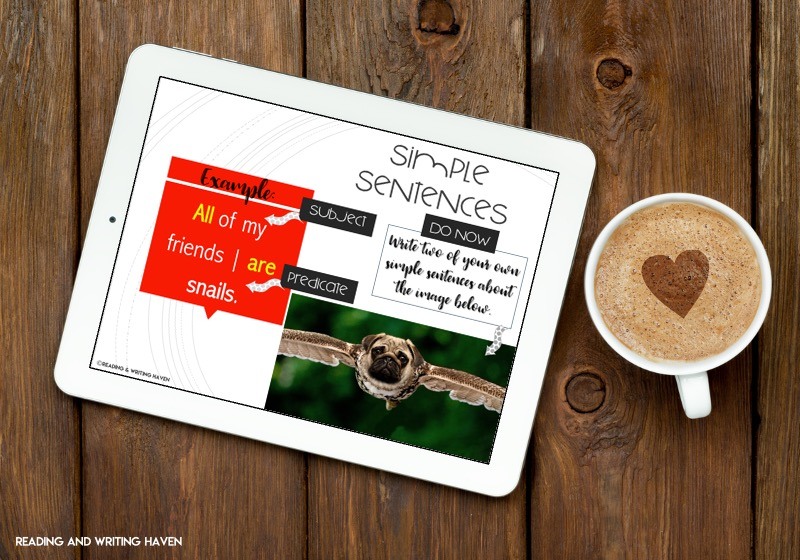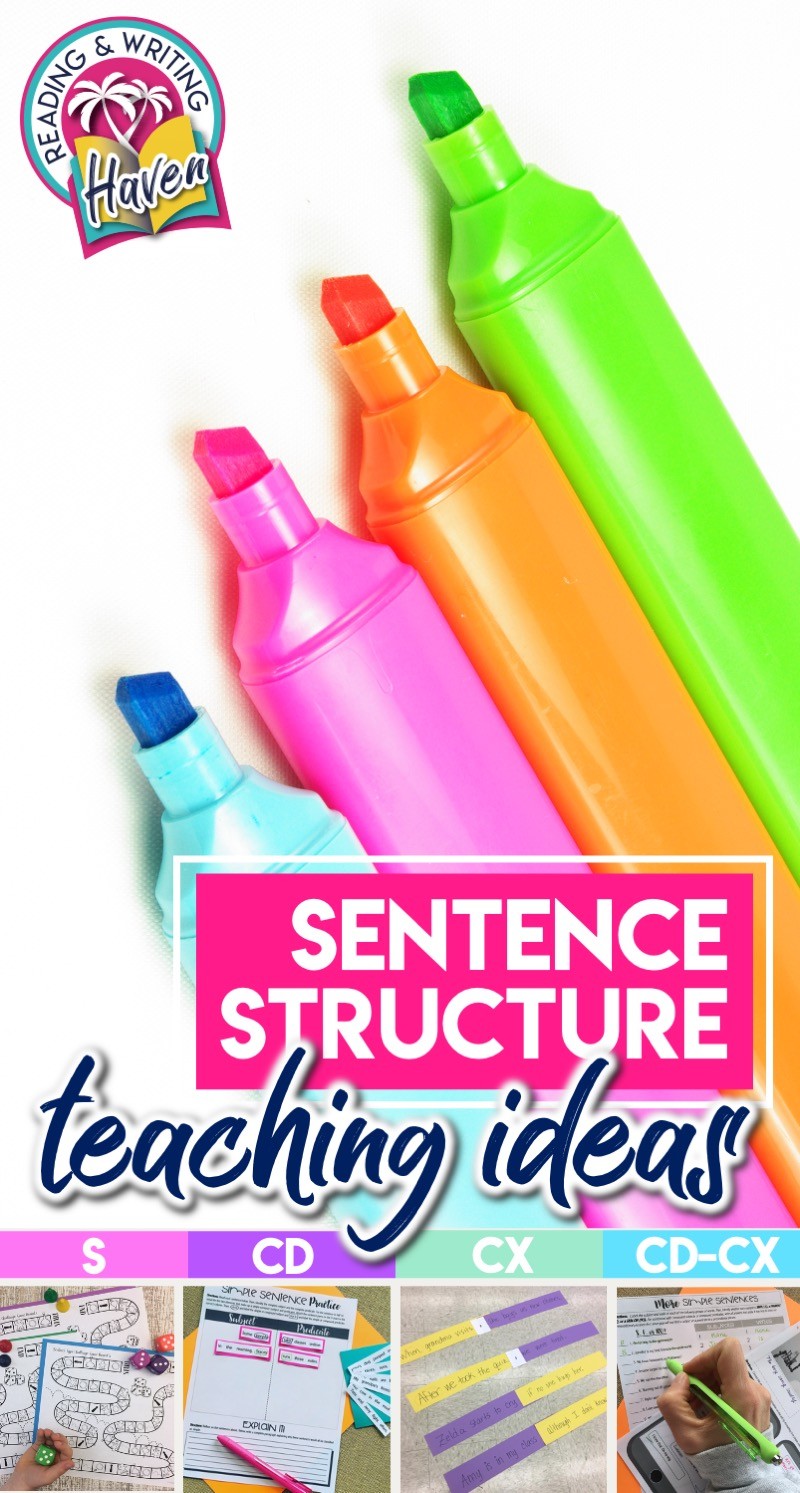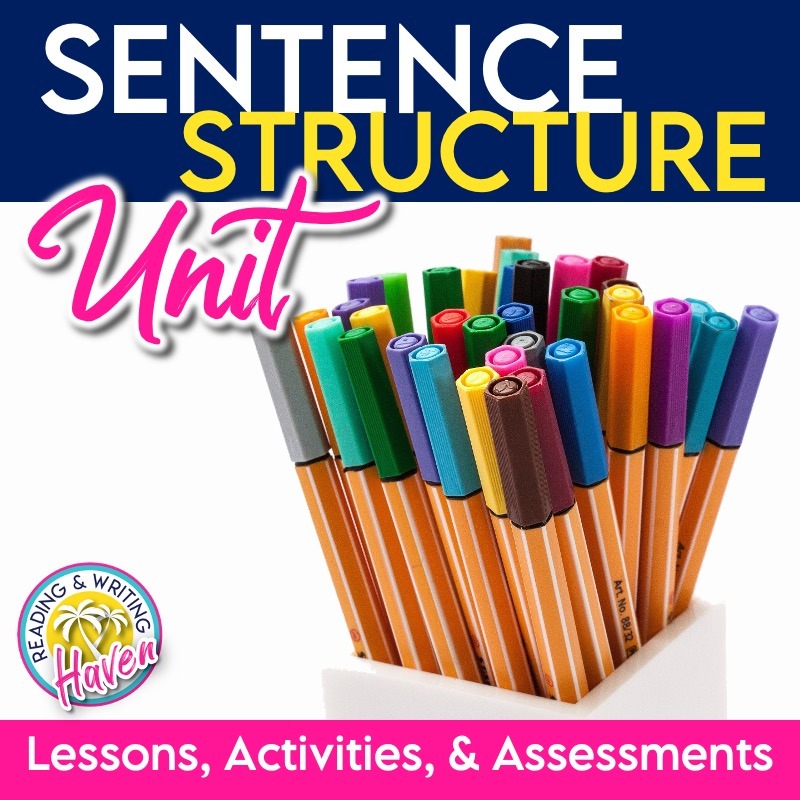How to Teach Sentence Structure: Simple, Compound, Complex, Compound-Complex
Wondering how to teach sentence structure? We’ve all seen plenty of student writing where sentence fluency issues abound. Teaching students to be aware of various sentence types as well as how to utilize them to create smooth, flowing pieces that leave a lasting impression on the audience is important in middle and high school.
There are so many ways to approach sentence structure instruction. The suggestions I’m sharing in this post are strategies I’ve found to be effective in secondary ELA classrooms after years of experimenting and tweaking. If you’re looking for guidance or inspiration, hopefully you can find some here.
Be aware of misconceptions.
In order to determine areas for growth, we need to know where students currently are. You can give a pre-test to get an idea. I use a page from this one, but you could easily make one to fit your needs. Pre-test data can also help you to identify common misunderstandings you might need to address.
There are some errors students seem to make consistently with sentence types. Consider:
- including a coordinating conjunction without a comma in a compound sentence
- using a subordinating conjunction as a transition (ex: Because, I like it.)
- inserting a semi-colon without a complete sentence on both sides
- lacking a comma after an introductory clause
Knowing these can help us tailor our instruction to provide extra support in areas of confusion.
Sequence the sentence types in a scaffolded way.
I teach sentence structure after I review parts of speech and sentence errors and teach parts of a sentence, and phrases /verbals. Rather than introducing all four sentence types at once, I roll them out one at a time: simple, compound, complex, then compound-complex. To clarify, we spend at least one week on each type. The latter two usually get two weeks each.
Introduce sentence types with mini lessons.
Try not to lecture for more than fifteen minutes. Use a visually appealing presentation to complement examples and modeling. Conveniently, sentence structure is an excellent skill to practice during writing workshop.
Then, either embedded in or directly following mini-lessons, incorporate guided practice. Most students need to walk through identifying, analyzing, punctuating, and writing sentence types with their teacher before they are truly ready to do so on their own.
But! Make it fun. My goal is similar to when I teach vocabulary and try to develop a true love for new words; I want students to love language. Bring in examples from their favorite books and/or nontraditional texts. Use social media (tweets, instagram posts, song lyrics, and more).
Give it time.
Sentence types, especially complex and compound-complex, need to simmer. Give students time to process, practice, and memorize (yes, I ask them to!) the most common subordinating conjunctions and relative pronouns. Acronyms help. Provide a reference list of other subordinating conjunctions and relative pronouns outside of the common ones just so students are aware that the acronym is not the complete list.
I don’t spend all class period every day on grammar. I introduce the sentence type with a mini lesson on a Monday (Monday Fun-Days!), and we review the concept throughout the week by identifying examples in the texts we read, analyzing how authors use them, and applying the skills in our own writing.
Using portions of worksheets as entrance and exit activities helps students to review the concepts frequently. Worksheets have a place. When students are acquiring basic skills, they need repetition. I try to make the sentences on my worksheets interesting, but sometimes students just have to get in their reps. It’s like lifting weights. Reps equate to strength. The way we utilize worksheets determines their effectiveness.
Incorporate some fun.
Don’t forget to throw in some tasty practice activities, like mazes, games, manipulatives, task cards, and crazy sentences. I have some in my sentence types bundle if you are looking for resources already made.
While this approach takes time, it’s beneficial. I’d rather spend a little bit of time all year to help students develop a solid foundation and understanding of important grammar concepts than teach them in a concentrated unit and never come back to them. It just doesn’t stick.
Differentiate up by requiring skill application.
One of the most important aspects of teaching grammar is showing students how grammar relates to reading and writing. Students should spend time applying their knowledge of sentence structures. Do they understand how to use the four types to craft a powerful paragraph or essay? Can they explain why they have included conjunctions, commas, and semicolons? Reflecting on and talking about writing as a class can bring this metacognitive practice to life.
One specific way you can guide students through this process is by using mentor sentences to analyze grammar and provide models. Here is a mentor sentence activity that uses opening lines from young adult literature and asks students to make thoughtful commentary on why the sentences are or are not effective leads.
Focus on subjects and verbs.
As I’ve analyzed how to teach sentence structure, I’ve learned that students who are most successful with the concept are able to identify the subjects and verbs in the sentences. They notice and label the subject and verb in both a dependent and independent clause. Once they are able to locate the dependent and independent clauses with ease, they can better grasp punctuation rules that apply to types of sentences.
Make it tangible. It’s hard for struggling students to understand sentence structure when the clauses are stuck on a page. Sometimes that approach doesn’t click. I’ve noticed that when I make manipulatives (pictured below) for students to use in small groups or as teacher-led intervention activities, the lightbulbs start going off. Asking students to color-code dependent and independent clauses and circle conjunctions has worked for me as well. Who doesn’t love highlighters?!
Teaching sentence types hasn’t always been fun for me. Now that I feel confident in my approach, it’s my favorite grammar unit. If you’re wondering how to teach sentence structure, hopefully you can take some of the ideas in this post and combine them with what you know about your students and your curriculum requirements. Questions? Feel free to drop them in the comments.
And, if you’d like more ideas for teaching grammar, read these related posts:
-
SEQUENCING GRAMMAR INSTRUCTION
-
DIFFERENTIATING A GRAMMAR LESSON
-
DESIGNING A GRAMMAR LESSON
-
FUN WAYS TO USE MENTOR SENTENCES
RELATED RESOURCE:
These are the unit materials I use when I teach types of sentences. The bundle contains presentations, practice exercises and worksheets, activities, quizzes, and reviews.




